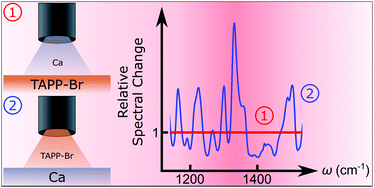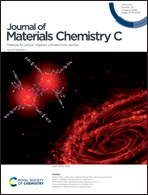Interface properties and dopability of an organic semiconductor: TAPP-Br variable as molecule but inert in the condensed phase†
Abstract
In situ infrared spectroscopy under ultra-high vacuum conditions reveals the behaviour of an example of a molecular compound, the n-conducting organic semiconductor (2,9-bis-(heptafluoropropyl)-4,7,11,14-tetrabromo-1,3,8,10-tetraazaperopyrene, TAPP-Br), upon condensation on various surfaces and as a mixture with typical dopants. The bending of molecules on Au(111) as previously established by inelastic electron scattering is seen also in infrared spectra of molecules on gold films, but clearly depends on temperature. It is indicated by modified infrared signals from C3F7 sidechain vibrations. If deposited onto MoO3, commonly used as p-dopant and interlayer material in organic electronics, infrared vibrational spectra are similarly modified while MoO3 deposition onto a preformed condensed layer did not produce any molecular change. Calcium, often used as an n-dopant, leads to further changes of the TAPP-Br vibrations in co-evaporated layers, specifically the modified C–C vibrations on the aromatic rings indicating charge transfer. Upon deposition of TAPP-Br on Ca films, a strong decrease of the metallic absorption of the Ca layer has been observed, which is typical for a chemical interface interaction. In contrast, for Ca deposition onto an already condensed TAPP-Br layer, a pronounced Ca island growth and thus enhanced diffusion and no significant vibrational changes are observed. Thus, chemical doping should be done before the molecules crystallize. Physisorption as well as chemisorption at interfaces strongly depend on the deposition sequence, which should be considered also for other organic semiconductors.



 Please wait while we load your content...
Please wait while we load your content...